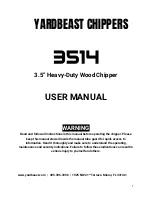
10 Decommissioning
10.1 Disconnecting
Only authorised personnel must disconnect the unit.
Avoid leak or spills into the environment.
Before disconnecting the unit, the following must be recovered, if present:
•
refrigerant gas
•
anti-freeze solutions in the water circuit
Awaiting dismantling and disposal, the unit can also be stored outdoors, if the electrical, cooling and water circuits of the unit have 100%
integrity and are isolated, bad weather and rapid change in temperature will not result in any environmental impact.
10.2 Dismantling and disposal
The unit must always be sent to authorised centres for dismantling and disposal.
When dismantling the unit, the fan, the motor and the coil, if operating, may be recovered by the specialist centres for reuse.
All the materials must be recovered or disposed of in compliance with the corresponding national standards in force.
For further information on the decommissioning of the unit, contact the manufacturer.
10.3 Directive EC RAEE
The manufacturer is registered on the EEE National Register, in compliance with implementation of Directive 2012/19/EU and relevant
national regulations on waste electrical and electronic equipment.
This Directive requires electrical and electronic equipment to be disposed of properly.
Equipment bearing the crossed-out wheelie bin mark must be disposed of separately at the end of its life cycle to prevent damage to
human health and to the environment.
Electrical and electronic equipment must be disposed of together with all of its parts.
To dispose of “household” electrical and electronic equipment, the manufacturer recommends you contact an authorised dealer or an
authorised ecological area.
“Professional” electrical and electronic equipment must be disposed of by authorised personnel through established waste disposal
authorities around the country.
In this regard, here is the definition of household WEEE and professional WEEE:
WEEE from private households: WEEE originating from private households and WEEE which comes from commercial, industrial, institutional
and other sources which, because of its nature and quantity, is similar to that from private households. Subject to the nature and quantity,
where the waste from EEE was likely to have been by both a private household and users of other than private households, it will be classed
as private household WEEE;
Professional WEEE: all WEEE which comes from users other than private households.
This equipment may contain:
refrigerant gas, the entire contents of which must be recovered in suitable containers by specialised personnel with the necessary
qualifications;
• lubrication oil contained in compressors and in the cooling circuit to be collected;
• mixtures with antifreeze in the water circuit, the contents of which are to be collected;
• mechanical and electrical parts to be separated and disposed of as authorised.
When machine components to be replaced for maintenance purposes are removed or when the entire unit reaches the end of its life and
needs to be removed from the installation, waste should be separated by its nature and disposed of by authorised personnel at existing
collection centres.
50
Summary of Contents for WSH-XSC3
Page 45: ...8 14 Compressor replacement 45...
Page 46: ...8 15 Exchanger replacement 8 16 Pump replacement 46...
Page 47: ...9 Accessories 9 1 Antivibration 47...
Page 48: ...48...
Page 61: ...Page intentionally left blank 61...
Page 62: ...Page intentionally left blank 62...















































